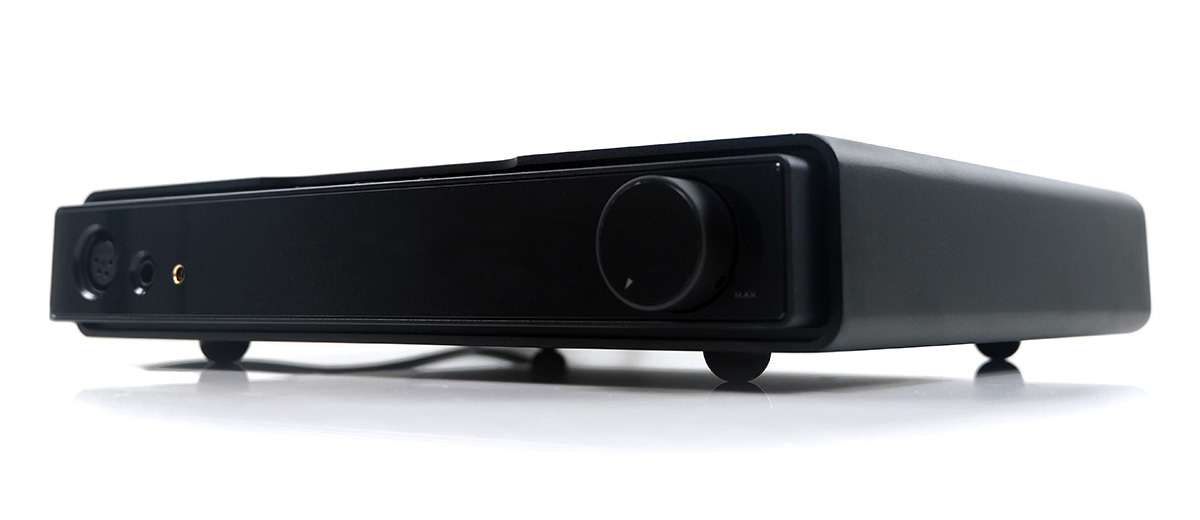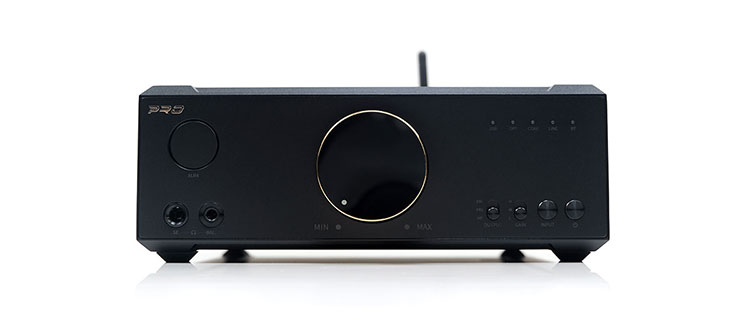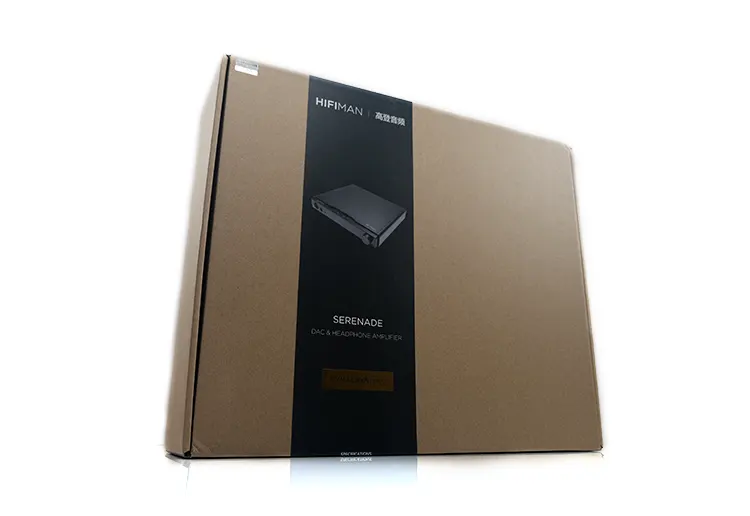Selected Comparisons
The following comparisons to the HIFIMAN Serenade were completed using an Audeze MM-500 and Meze Audio’s Empyrean II, with a mixture of USB-DAC and LAN-delivered lossless audio.
YULONG DA10
The YULONG DA-10 was launched in late 2019 and for us here at Headfonics, it was one of the standout units of a new wave of all-in-one systems for headphone users at this price point. You can read our full review of the DA10 here.
Technical
Probably the most significant internal difference is the DAC/USB chipset combination with the DA10 equipped with a delta-sigma AKM AK4497 as opposed to the Serenade’s in-house HYMALAYA Pro R2R modular chipset.
The USB input inside the DA10 is handled by an XMOS XU208 which is a lower tier compared to the Serenade’s XU316 but offers a higher DSD 512 and PCM 768kHz decoding rate compared to PCM 384k and DSD256 inside the HIFIMAN unit.
Both units use a proprietary FPGA with their own algorithms for incoming digital signal sampling though the Serenade implementation has no classic NOS/OS sampling whereas the DA10 pulls 3 from its DAC chipset.
The DA10 does not have any LAN streaming or has any way to bypass the DAC with an analog line-in similar to the Serenade.
Both offer volume-controlled and fixed line-out capability with the DA10 offering a maximum of 4.2Vrms balanced and the Serenade slightly higher at 4.5Vrms balanced.
If I am not mistaken the amplification topology is quite similar with both using a discrete Class A-based design with JFET input. However, it does seem the DA10 has a bit less grunt inside at 3W into 32Ω and 460mW into 300Ω balanced compared to the more powerful 4W into 32Ω down to 760mW at 300Ω equivalent from the Serenade.
Both offer single-ended options which is where the DA10 has a bit of a weakness for high impedance headphones 300Ω upwards at 230mW and at 600Ω it is rated at 110mW.
This is not an ideal match to the likes of the ZMF Headphones Atrium’s driver which can handle more mW power. The Serenade fares much better for high impedance on its SE output at 510mW @300Ω.
Design
The DA10 is about functionality over aesthetics. It’s a plain Jane black box compared to the sleeker and more curvy visual of the Serenade. Despite being a more compact form factor it’s still a heavier proposition at 4kg compared to the HIFIMAN’s 2.9kg rating.
Despite the understated form factor, I find the DA10 layout and control suite to be quite useable with an excellent and easy-to-read LED screen. The Serenade screen is no less legible but perhaps conveys slightly less accessible information.
For example, the DA10 offers its sound tweaking and filter control suite modes from the LED which the Serenade does not provide, (not a feature provided by the FPGA or DAC).
The Serenade’s advantage is the simpler 3-button physical control system meaning the volume control is just for volume only. You can hit round-robin your inputs or outputs independently and quite quickly.
The DA10 controls are from a push-controlled volume dial that doubles as a selector. That gives it more of a linear feel to the navigation making it slightly slower for quick changes to features deeper in the system.
Perhaps it’s an age thing, but the DA10 lacks the Serenade’s 4.4mm balanced output, something that was less popular in 2019. It also lacks LAN connectivity at the rear panel as well as an analog line-in meaning everything starts from the digital input side and everything must go through the DA10 DAC.
Performance
There are a lot of nuanced differences but the major one for me is the dynamic range performance between these two amplifiers. The DA10 imaging and dynamic range sounds lacking to my ears with the MM-500. It is something I noticed in one or two other amp/DACs with the same chipset.
You get a lot of thrust and power from the lows of the DA10, perhaps even more sub-bass body than the Serenade. However, from there it just fades and shrinks in presence with a thinner upper mids and treble.
Polished? Yes, it’s delta-sigma, and I always find you get that cleaner tone in part on the highs. However, it sounds glassy compared to the liquid-like edges and the enhanced body of the warmer Serenade.
In short, I find the instrumental timbre through the mids and highs to be more natural to relaxing from the Serenade/MM-500 combo whereas the DA10 might sound clearer but more digital and lacking in presence and impact.
That earlier mention of fade in the DA10’s performance beyond the lows leaves the staging a bit bottom-heavy with the result that it’s not as open or as airy sounding as the Serenade. It lacks complexity through the mids and does not sound as wide or as open in its presentation.
As a result, the overall DA10 soundstage sounds a bit flat and smaller paired with the MM-500 when compared to the Serenade. Power could well be a factor here, the DA10 has less of it, but I found the lack of dynamics to be more about the amp rather than the AKM DAC in my 2019 review.
Shanling EM5
The Shanling EM5 was launched in early 2022 and though its bias is more strongly to the streaming side of desktop headphone audio it does offer a very strong ‘all-in-one proposition. It also won our Top Gear Award for Best Streamer in 2022.
Technical
The EM5 is packed full of features so stripping this one down to the essentials. Inside, like the DA10, this is a delta-sigma DAC implementation as opposed to the HYMALAYA Pro R2R module with a lower tier AK4493EQ.
The digital bridge is also FPGA controlled with a USB ComTrueCT7601 whereas the Serenade has a custom-designed algorithm. Decoding rates are on par though at up to PCM 32BIT/384kHz as well as DSD256 natively, and DSD512 via a software layer whereas DSD512 is possible along with PCM 768kHz via LAN on the Serenade.
One important thing to mention is the use of Android as its OS giving it a garden-wall app layer. It’s an old but gold Android 7 version powered by a Qualcomm Snapdragon 430 CPU so nowhere near modern levels but functional for audio requirements on the EM5.
Because of that it also offers bitperfect output which is not needed on the Serenade as it does not rely on Android OS layering.
Both units offer streaming with LAN RJ45 ports with the EM5 also offering Bluetooth and LDAC support. The EM5 also has additional WiFi capability, and that software layer and accompanying Shanling app for phones give it a very wide range of DLNA/Airplay connectivity options.
Both have pre-out and headphone output amplification though the EM5 lacks an analog input. The amplification stage is also a little less high-end with mainly opamps including 2 x TPA6120A2 for the headphone side and 2X Muse8920 for the pre-amp as opposed to the Class A/FET setup of the Serenade.
The output power on the EM5 is also more modest at 540mW @32Ω SE and 1.62W going balanced. It will do well with most moderately sensitive headphones but the Serenade will offer more headroom at 4W into 32Ω.
Design
The EM5 is somewhat closer to the DA10 with its boxy design save for a few gold-coated motifs such as the multi-function volume dial. It’s not as snazzy looking as the Serenade physically but it is more compact and better suited for smaller desktop spaces.
However, there is no front-facing LED, rather the LED and touch-capable software control suite is on the top panel.
Pros and cons here. I prefer the Serenade’s simple-to-use visual interface and physical controls on the front panel for general audio listening. The EM5 is less useable manually unless you are standing over it so I would suggest moving to the Eddict App instead for a better control experience.
The fact you do have an app though means you have a form of remote control which is lacking for the Serenade. Granted, you can control the Serenade via some 3rd party app if your LAN is set up for remote streaming options but the depth of controls is more limited with that lack of WiFi connectivity.
The EM5 also has a lot more digital I/O options with 32GB onboard memory for local playback and microSD expansion. It also has 2 optical and 2 coaxial for input and output as well as additional USB-A input alongside the standard USB-B input. It does not have an analog SE input to bypass the DAC similar to the Serenade, just digital to a 3rd party DAC.
Both units have a similar PO lineup on the front panel with provision for SE 6.35mm and balanced 4.4mm/4-pin XLR outputs.
Performance
There is no shortage of dynamics from the EM5 Amp/DAC performance with the Empyrean II. Both of these amps have good depth, excellent vocal presence, and no issues with power.
The difference for me is just how emphasized the bass impact, upper mids, and lower treble are on the EM5 relative to the rest of the instrumental presence. This is an old-school DAC chipset and one that I have always enjoyed because of its impactful lows and forward vocal imaging.
It’s a joyful energetic sound but at the same time lacks a bit of refinement and here is where the more relaxed and smoother tonal quality of the Serenade has some advantages.
Percussion and sibilance can be a weak spot with the EM5 with some slight roughness on percussion and some sharpness when higher-pitched sibilance kicks in. You get none of that with the Serenade whose creamier richer tones have a more natural and agreeable lilt for the same percussion and sibilant moments.
You could argue that the Serenade is comparatively softer, and more languid in its delivery, and to some extent that is correct. The EM5 is more ‘hurried’ in its tuning, stronger on the bass with more fizz but those key areas are dominant leaving everything tucked in behind a little.
The Serenade/Elite combo does better in teasing out the entire stage, both backing instrument and main vocal. Vocals still have excellent presence but the better width and height give instruments more space and as such a more complete picture of the performance.
FiiO K9 Pro ESS
Released in early 2022, the FiiO K9 Pro ESS is the company’s flagship desktop all-in-one solution for headphone users. There are several variations of this unit such as the earlier K9 Pro which used an older AKM chip and a new but cheaper K9 with a lower tier chipset.
Technical
The K9 Pro ESS DAC design is also delta-sigma and draws a lot from their flagship M17 DAP with a dual-mono ES9038PRO implementation in current mode.
In some ways, HIFIMAN has the same approach with a lot of their mobile devices leading the charge with their model R2R HYMALAYA chipset and the Serenade coming in later with the equivalent or Pro version in this case.
There is no FPGA inside the K9 Pro ESS, instead, it is managed primarily through a lower-tier XMOS XU-208 with decoding rates on par at DSD256 and PCM 32BIT/384kHz for USB but lower than the Serenade’s DSD512 and PCM 768kHz ceiling when using LAN.
The big feature gap is streaming via LAN which the Serenade offers whereas the K9 Pro ESS has no LAN streaming port and instead offers BT with LDAC support.
Both units are very much company signature designs for amplification with FiiO using THX788+ which is an exclusive spin on their 788 chipsets used in desktop amplifiers and HIFIMAN using a discrete Class A/JET topology.
Both offer balanced and SE output options for PO and LO with the Serenade offering more output capability at 4W compared to the K9 Pro ESS’s 2.1W into a 32Ω load going balanced. The K9 Pro ESS also has a very good on-paper output level for high-load 300Ω headphones at 1.1W.
Design
The K9 Pro ESS is boxy like the other 2 compared units but of the entire line-up with the smallest all-in-one form factor.
Although taller than the Serenade it is much narrower and not as deep making it a better fit for tight desktop spaces. The inclusion of a vertical stand also means you have more placement options available to you for the K9 Pro ESS.
The aesthetics of the K9 Pro ESS are more muscular and ‘Gen Z’ compared to the matured curves of the Serenade. FiiO’s in-house design is very consistent these days with that ‘mecha’ inspiration so it’s angular, modern, and aggressive in its profile whereas the Serenade has a lower profile, more minimalist, and more refined overall for my taste.
The K9 Pro ESS does lack any sort of onboard visual interface. All physical controls are switch-based or via the multifunctional volume dial. The Serenade physical control format is more elegant and legible for me with an excellent LED screen for an instant status check.
You do, however, have the FiiO Control app which can link with the K9 Pro ESS via BT to give you a semi-remote control as well as some additional EQ and filter selections.
This is something I would have loved to have seen HIFIMAN developed for the Serenade. Though it has LAN which the K9 Pro ESS lacks, the connection is more dependent on 3rd Party software.
I/O on the front match with similar balanced SE PO outputs. Like the Serenade, the K9 Pro ESS offers an SE line-in on the rear panel and goes one output further with an additional 4.4mm balanced line-in which I find handy for linking up DAPs with a balanced line-out connection.
Performance
I thought these competed nicely against each other with the deciding factors on what one is right for you more of a tonal and staging preference.
The K9 Pro ESS is more neutral in its coloration though I wouldn’t call it bright, rather it’s just more clinical and exacting with a little more warmth on lows and slight hardness in its leading edges over the upper mids and highs.
You will immediately notice the sweeter smoother tone from the Serenade but what I didn’t expect was the additional treble sparkle which was slightly missing from the FiiO. It extends well but the presence and air weren’t quite up to the airy grandiose performance of the Serenade.
That changes the staging shape with the FiiO offering more robustness on the lows giving it an edge in depth and aggression but perhaps not as wide and tall as the sweeter more atmospheric tone of the Serenade.
Kudos to the K9 Pro ESS imaging though, it has excellent dynamic range and imaging complexity to go along with it despite a comparative reduction in overall staging size.
Those contrasting performances did shape my pairing preferences. Headphones such as the Empyrean II did better with the Serenade with its larger soundstage sounding more filled in compared to the K9 Pro ESS. The more refined mids and treble also played well with the excitable thinner Empyrean II highs.
I was more on the fence with the MM-500 with the K9 Pro ESS pairing delivering a stronger and more impactful bass performance whereas the Serenade sounds more open through the mids, and perhaps slightly more relaxed and smoother on the vocals also.
Our Design
The HIFIMAN Serenade is a very capable ‘do-it-all’ DAC/Amp with a warm tone and excellent staging qualities that make it an ideal, albeit somewhat relaxing, pairing with headphones known to deliver a big soundstage. The refined LAN audio service I might prefer over its USB audio equivalent.
There is enough headroom to drive demanding headphones with plenty of options for both balanced and unbalanced connections to the rear and the front. A sleek modern design profile makes it an attractive option for any moderately sized Hi-Fi rack.
It will not win over neutrality fans and detail freaks with some amps also delivering a more powerful low-end more suited to those looking for a strong bass response. This is primarily for easy listening with a smooth and inviting playback quality, especially for vocals.
HIFIMAN Serenade Technical Specifications
- Frequency Response 20-20kHZ, +/- 0.1dB @ 1KHz
- SNR 110dB, 0dBFS @ 1KHz
- THD+N 0.0015%, -3dBFS @ 1KHz
- Balanced Output: 4000mW @ 32 ohms, 760mW @ 300 ohms
- Single-Ended Output: 2800mW @32 ohms, 510mW @ 300 ohms
- Line-out: 4.5V/XLR, 2.2V/RCA, 0dBFS @ 1KHz
- USB: PCM 32bit/384k, DSD64-DSD256
- Coaxial, Optical: PCM 32bit/192k, DSD DoP64
- LAN: PCM 44.1 – PCM 768k, DSD64 – DSD512
- Dimensions/Weight: 330x50x255mm, protrusions not included / 2.9kg






